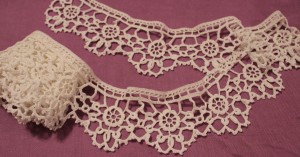Ready for a Petti
October 12th, 2011
My guipure petticoat trim is complete! It measures just a bit longer than 150 inches — perfect to apply to one of my three breadth (of 45 inch muslin) petticoats.
I know this one will have a sufficient hem (for a change). But the question is, how many tucks will it sport? What will be their pattern? No embroidery. At least that’s what I’m thinking right now…
Crochet Class
October 2nd, 2011
Yesterday afternoon, eight ladies and two gentlemen gathered in the basement of the Ottendorfer Library under the auspices of the New York Nineteenth Century Society to learn about crocheted lace. I was drafted to deliver the opening remarks, since I’ve been reading about crochet lately, thanks to my petticoat obsession project.
After my little speech, complete with a few gems culled straight from period sources (stay tuned for a full article on early crochet as soon as I get the time to put it together), everyone whipped out their hooks. We began making samples from the triangular looped 1855 pattern I found in Peterson’s and used for my recently completed petticoat.

Luckily, everyone there already knew how to crochet. I was just leading them a bit further down the primrose path to needlework insanity. They caught on quickly, producing impressive headers for their samples, and even getting so far as the first row of loops. The photo above shows one of our talented hand-work circle members in mid-double-crochet.
Here’s an audio excerpt from the introduction I gave. Before you listen, a couple of possible errata. I call point lace an embroidered lace, but I think it would be more accurately termed a needle lace. Also, I say that Peterson’s is searchable on ProQuest. I don’t believe it is…but there is another major database that many research libraries do carry with Peterson’s, if I could only remember which one!

After I finished my little speech, everyone set to work. I wandered around helping as needed, and working on my own petticoat trim. To make it more portable, I wrapped it around my neck (as captured in this photograph by my handsome and talented father, who was in attendance).
Guipure Trimming
January 11th, 2011
Some women indulge themselves with expensive perfumes, dark chocolate, or spa visits. I subscribe to Accessible Archives. For a modest yearly fee, I can search every issue of Godey’s Lady’s Book ever published, not to mention lots of other great historical sources. The only down side is that since I find whatever I want immediately, I rarely bother to browse. And browsing is the best way to come across what you aren’t looking for.
Peterson’s Magazine, a Godey’s copycat, is searchable only through a very expensive academic database. So I read back issues, bound by the year, thanks to Google Books. I was browsing Peterson’s 1855 for chemise patterns when this showed up:

Given my recent obsession with petticoat trimming, I earmarked it for a trial run. And last week, I pulled out my crochet hook and a skein of cotton thread and whipped up 4 repeats of the pattern. Since the way thread and needle sizes are designated have changed since the 1850s, it’s always a bit of a guessing game to see which you should use. I had number 16 cotton on hand, and a size 10 (1.3 mm) crochet hook. The hook was a little small for the thread, but the next one up in my kit was far too big.
I really like the way this pattern looks. Though I would prefer a finer thread. Probably a great deal finer. Like most crochet edgings, it starts with a chain as long as you will require. There are only 7 rows, but at least two are quite involved. I think it would be slow going to trim a full petticoat, though not nearly so slow as Broderie Anglaise. And the effect would likely be stunning.
I had to fiddle with the pattern a little to make it work; thank heavens for the picture, which helped with intuitive leaps when the written directions became unclear. Some of the changes I made might not have been necessary though if I’d been using finer thread…and the end result would likely have been neater.
Oh, and if you are afflicted with curiosity, like me and the cat, real guipure is a heavy needlepoint lace in which the patterns are connected by thread ties or mesh. True lace, which was phenomenally expensive in the mid-19th century, was often imitated by crochet. One of the most noted examples of this is the legendary Irish crochet: “faux” laces created with great dexterity and sold by women to support their families during the Famine. Incidentally, by the end of the 19th century, exquisite Irish crochet was valued on its own merits, rather than its ability to mimic more expensive laces.
« Newer Posts

